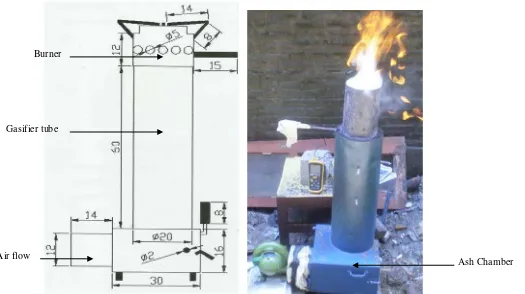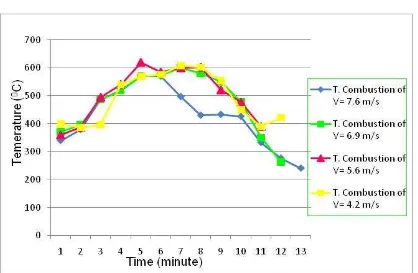ANALYSIS OF COMBUSTION TEMPERATURE IN
THE CHOPPED WOOD GASIFICATION PROCESS
WITH AIR VELOCITY VARIATION
Wijianto, Subroto, Sarjito
Mechanical Engineering Department, Universitas Muhammadiyah Surakarta
[email protected] (wijianto)
Abstract
The general definition of gasification is thermo-chemical process of solid fuel form which
becomes gas fuel with limited supply of O2 and it produces CH4, H2, CO, and impurity
compound such as H2S, CO2, and tar. The objective of this research was to determine the
influence of air velocity toward combustion temperature in order to invent the best values of
air velocity for chopped wood gasification process.
The research was commenced by preparing chopped wood as material for downdrft gasififier.
Subsequently, glasswool was utilized as gasifier isolator in the gasification process to isolate
heat in order to obtain the best heat efficiency. In the gasification processes, variaton of air
speed was applied. The sample was chopped wood with gasification furnace in which the
results of combustion temperature and combustion time were analyzed.
The result indicated that the highest temperature was not depends on the fastest air flow
velocity. Instead, it required a precise air flow velocity to gain the highest temperature. It was
evidenced that the highest temperature gained was at 620
0C with v = 5.6 m/s air flow
velocity. The longest gasification process was 13 minutes at v = 7.6 m/s and the fastest
gasification process was 11 minutes at v = 5.6 m/s.
Keywords: Chopped wood, gasification, downdraft gasifier, air velocity.
Presenting Author’s biography
1.
General
Despite the ongoing unresolved problem in providing fuel in home industry, the consumption of crude oil in Indonesia is relatively high, even though Indonesia’s fuel reserves is less than 0.5% of world’s fuel reserves. Debate continues related to the best strategies to manage our fuel reserves, but crude oil is not-renewable energy. This condition forces the finding of other energy resources which are easy to obtain and apply in Indonesia.
Biomass has been highlighted and studied to be an alternative energy in the past years. In fact, Indonesia has abundant biomass resources as the result of organic waste from numbers of home industries. In addition, biomass has other benefits, such as its ability in recycling CO2 and employing
organic waste from home industries.
Ministry of Forestry (1990) has confirmed more than 50.2% of potential waste is derived from wooden coping industry. Based from that data, a huge potential of chopped woods is available to be re-used as an alternative energy. However, approaches on how to process this potential are limited and rarely discussed. Chopped woods are frequently used simply as conventional combustion fuel resources which only cause air pollution. Several studies on energy conversion have been used to solve energy crisis, yet direct combustions such as pyrolysis, anaerobic digestion, and gasification are still the prevailing methods. Each of them has their respective advantages and disadvantages. The gasification technology is preferred as it is relatively simpler and easier.
Methane gas can be generated from gasification process with chopped woods and others biomass as source of combustion. Gasification produces hydrogen, carbon monoxide, and other chemical compounds which are also environmentally friendly. Moreover, gases that are produced by gasification are easier to be controlled by burner and air velocity that pass the gasifier in the gasification process.
Nevertheless, there are only few researches of the utilization of gasification in Indonesia. Whereas, gasification products are useful for cooking, rotate turbine, power up internal combustion engine, and so on (Tasliman, 2006). By those facts, gasification technology is really suitable to be developed in Indonesia. Furthermore, it needs visceral research before this technology going to be mass production product.
A study on wood furnace with gasification system was carried out by Reed et al. (2000) which resulted the fact that blower with 3 watt power was able to produce 1-3kW heat. Moreover, it adds 30% more efficiency in cooking process[1] Belonio (2005) staked out Rice Husk Gasification Furnace
with updraft system. Belonio designed the gasifier very simple by linking up ask chamber, fan chasing, gasifier and burner into one body[2]. Another research conducted by Subroto (2007) reaffirms
combustion temperature distribution of husk which are evidenced to have better yield than cob and bagasse. It has been shown that water boiling time of husk is the fastest than other samples. Nonetheless, heat value of bagasse is higher than husk but bagasse has lower peak temperature than husk. It indicates that the root cause of solid fuel gasification is the design of gasification furnace. The design must be adjusted with the type of fuel [3]. Pathak et al. (2008) evaluated down draft gasifier
2.
Research Methodology
Figure 1. Dimension of downdraft gasifier
Research was commenced by isolating the hollow space between inner surface and outer surface of downdraft gasifier with glasswool and filling it with chopped wood which is crushing with mesh 10 and water content of 10% until the gasifier was full (it was about 1.3 kg of chopped wood). Chopped wood was not specified as it was obtained from several species including teak, mahogany, and other woods.
The next step was to switch on the fan with 7.6 m/s of air velocity. A piece of paper was burned on the chopped wood to raise the combustion process. Subsequently, the gasifier was covered with burner as the combustion process occured. Combustion times were recorded from the starting to the end of the flame.
The record of the temperature used thermocouple reader which was placed in the top of burner in three diferent points (T1, T2, and T3). In addition, thermocopule was also placed inside the burner with three diferent positions (t1, t2, and t3), which was determined by the height and depth of the fire on the burner. Similar method was applied on the air velocity of 6.9 m/s, 5.6 m/s, and 4.2 m/s.
Gasifier tube Burner
Air flow
3. Result and Discussion
Figure 2. The times and temperatures of air flow velocity variations.
Based from Figure 2, the highest temperature takes place at the fifth minute of the third experiment with the temperature of 6200 C. The lowest temperature was 2400 C in the first experiment. The longest
gasification process was the first experiment with total time more than 13 minutes and the shortest gasification process was the third experiment of 11 minutes. The analysis indicated the insignificant relationship between air flow velocity with time and temperature of chopped wood gasification.
Figure 3. Comparison on the characteristic of fire temperature. 0
100 200 300 400 500 600 700
T1 (0C) T2 (0C) T3 (0C) t1 (0C) t2 (0C) t3 (0C)
7.6 m/s
6.9 m/s
5.6 m/s
4.2 m/s
Tem
p
er
a
tu
re
(
0C
6.9 m/s of air flow velocity had the highest temperature than others, except at T3. It indicated that the
most suitable air flow velocity for chopped wood gasification is this flow velocity specification.
4. Conclusions
Based on the data processing, several evidences on the correlation between air flow velocity
and combustion temperature on chopped wood gasification were as follows:
1.
The highest temperature had insignificant correlation with the fastest air flow velocity. It
required ideal air flow velocity to gain the highest temperature. It can be shown from the
highest temperature which was gained at 620° C with v = 5.6 m/s of air flow velocity.
2.
The longest gasification process was 780 seconds at v = 7.6 m/s. Whereas, the fastest
gasification process occurred at v = 5.6 m/s in 698 seconds. The study figured out the
insignificant difference among air flow variations, thus, correlation between gasification
time and air flow velocity can be considered as insignificant.
References
[1] T.B. Reed, E. Anselmo, Kircher. Testing and Modelling The Wood-Gas Turbo Stove. Progress in Thermochemical Biomassa Conversion Conference, September 17-22, Tyrol, Austria. 2000.
[2] A. T. Belonio. Rice Husk Gas Stove Handbook. Department of Agricultural Engineering and Environmental Management College of Agriculture, Central Philippine University, Iloilo City Philippines. 2005.
[3] Subroto. Perbandigan pans pembakaran proses gasifikasi sekam padi, tongkol jagung dan ampas tebu.2007.

